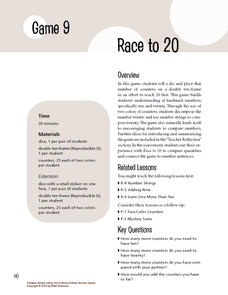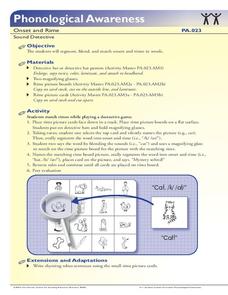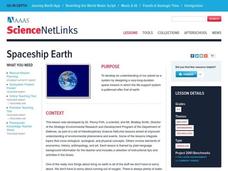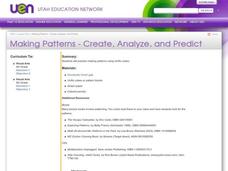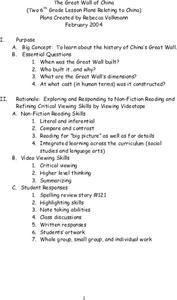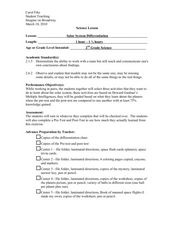World Wildlife Fund
Arctic Take 6
The magic number is six! Using a 6x table, young math stars practice adding, subtracting, multiplying, and dividing two-digit numbers with the number six. This worksheet also touches on making tessellations with hexagons.
Houghton Mifflin Harcourt
Surprise!: Challenge Activities (Theme 2)
Surprise! is the theme of this series of challenge activities. The surprise comes from the information your scholars will discover when researching topics such as alligators and crocodiles, living in other countries, becoming a...
Curated OER
The Envelope Guessing Game
Students work with a partner by using the symbol bracelets from lesson #1. They that has the number #1 look at the object keeping it hidden from student #2. Student number 2 then ask questions in order to determine the qualities and...
Mary Pope Osborne, Classroom Adventures Program
The Backpack Travel Journals
Strap on those backpacks, it's time to travel through history with this literature unit based on the first four books of The Magic Tree House series. While reading through these fun stories, children create story maps, record interesting...
Curated OER
I Spy Poetry
Students identify and interpret the rhythm and form of the I Spy poem.
They then integrate art, music, literature, technology, and writing with poetry. Students also write their own poem based on the picture they printed from the I Spy...
Curated OER
Where are all the Animals?
Students view animals that camouflage at the Shedd aquarium website. In this camouflage lesson, students recognize that there are different types of camouflage, cryptic coloring, counter-shading, warning coloration and mimicry. Students...
Curated OER
Freddie Feels
Students become aware of the sense of touch and the body parts effected by touching. In this five senses lesson, students touch mystery items and create a touch page. Students discuss the body parts connected to the sense of touch.
Curated OER
Ancient Egypt
Pupils use the internet to gather information on Ancient Egypt. Using this information, they create their own name cartouche using markers and construction paper. They also make pyramid cutouts and draw pictures of the Great Sphinx.
Curated OER
The Five Senses
Study various objects and help kindergarteners use their five senses to classify the objects. They are presented with various objects and then use their five senses to sort and classify the objects. Then they use a Visual Ranking Tool to...
Math Solutions
Race to 20
And they're off! Working in pairs, young mathematicians roll dice to see who can fill in their double ten-frames first. When learners finally fill in their arrays, they create addition number sentences that represent their rolls, helping...
Curated OER
Who am I? Bookmaking
Students explore the process of bookmaking that has its origins from many different international cultures. The multicultural symbolism represented by the medium is utilized by students to expres their identity.
Curated OER
Mystery Polymers
Middle schoolers examine how some natural substances are polymers. In this polymer lesson students complete a lab and give examples of a physical change.
Curated OER
Bible Activities-- The Easter Story
In this Bible activity worksheet, learners learn the story of the first Easter from the Bible and complete a variety of puzzles, codes and coloring pages.
Curated OER
I Spy Poetry
Explore the components of rhythm and form through a reading of Jean Marzollo's I Spy books. After discussing Marzollo’s format, the class agrees upon a theme for a class book and topics that fit with that theme. Pupils write a poem,...
Florida Center for Reading Research
Phonological Awareness: Onset and Rime, Sound Detective
Play letter sound detective with your class, and snoop out sounds, onsets, blends, and rhyme. In pairs, children take turns choosing a card from the pile; as they sound out part of the word, their partner attempts to figure out which...
Curated OER
Spaceship Earth
Students develop an understanding of our planet as a system by designing a very-long-duration space mission in which the life-support system is patterned after that of earth.
Curated OER
Under the Sea - KWL Chart
Students create a KWL chart to start the discussion on ocean animals. They practice sorting the animals into their different classifications. They use indexes, table of contents and glossary to find information.
Curated OER
Flying High in Ohio
Her is a lesson using the Ohio State Quarter. Pupils utilize beautifully-designed worksheets embedded in the plan, to study about the origins of aviation. Many of the pioneers of aviation were born in Ohio. They compare some of the...
National Security Agency
Equations and Expressions
Learners demonstrate their knowledge pictorially, concretely, and abstractly in this unit meant to last three hours over three days. Using hands-on activities, manipulatives, real-world applications, and problem solving, learners write...
Curated OER
Making Patterns - Create, Analyze, and Predict
Fourth graders practice making patterns using Unifix cubes and identify, analyze, and determine rules for describing numerical patterns involving operations and nonnumerical growing patterns. They also find an example of a pattern in...
Curated OER
The Great Wall of China
Sixth graders watch the video "Great Wall of China". They use the template to design their own postage stamp to show something learned about the Great Wall. They determine a presumed price for the stamp in Chinese currency and ...
Curated OER
Solar System Differentiation
Students explore the solar system. In this solar system science instructional activity, students choose 3 out of 12 centers to visit, each of which contains an activity related to the planets. The station activities are designed to...
Curated OER
Microsoft Word~About the Author
Fourth graders investigate how to create a document named "About The Author". The teacher uses a LCD projector to guide the instruction and provide examples for the class. They also include graphics in the document and practice accessing...
Curated OER
Water and Ice
Learners examine how water changes state, from a liquid to a solid. In this water lesson students study the water cycle and how temperature and pressure effect it.











